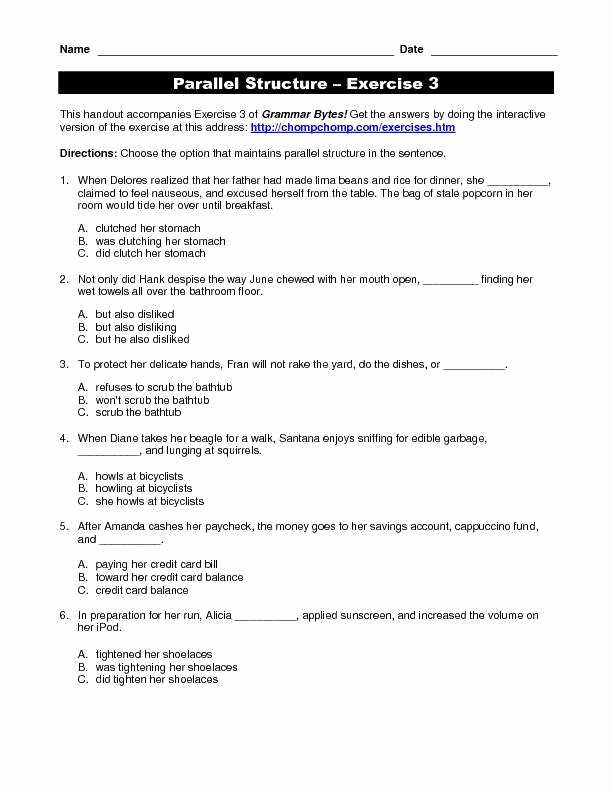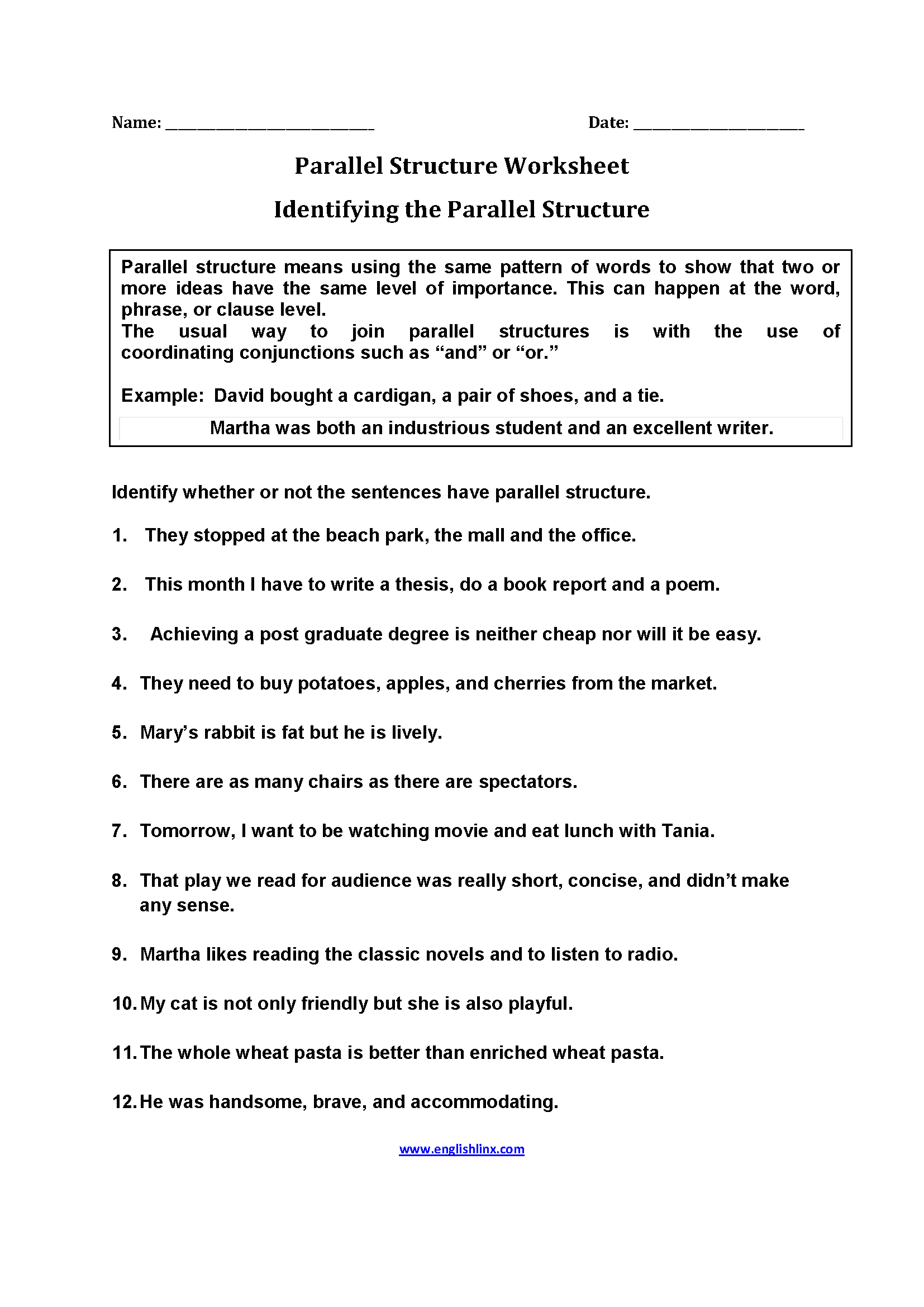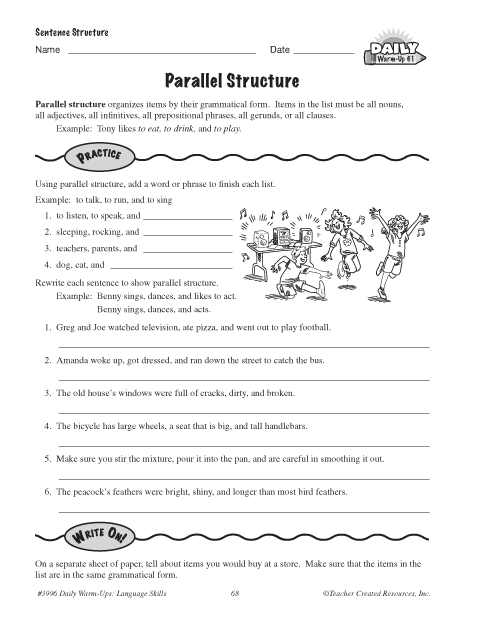
Mastering Grammatical Harmony: The Indispensable Role of Parallelism Worksheets
In the intricate tapestry of the English language, where clarity, rhythm, and impact converge, few grammatical concepts hold as much power as parallelism. Often referred to as parallel structure, this principle dictates that elements in a series, comparison, or list should share the same grammatical form. Whether it’s a list of nouns, a series of verbs, or a comparison of clauses, maintaining parallel structure ensures elegance, conciseness, and persuasive force in writing and speech. Yet, for many learners, mastering this crucial concept requires more than just theoretical understanding; it demands consistent, targeted practice. This is where parallelism worksheets become an indispensable tool, guiding students from confusion to confident application.
The journey to grammatical proficiency is rarely linear, and parallelism, with its subtle nuances and common pitfalls, often presents a significant hurdle. Students might intuitively understand that "I like running, swimming, and to bike" sounds awkward, but pinpointing why it’s incorrect and how to fix it consistently is another matter. Parallelism worksheets provide the structured environment necessary for learners to identify errors, internalize correct patterns, and ultimately, produce more sophisticated and impactful prose. This article will delve into the profound importance of parallelism, explore the multifaceted benefits of utilizing well-designed parallelism worksheets, examine the types of exercises they offer, and discuss their vital role in fostering strong, clear, and compelling communication skills.
The Essence of Parallelism: Clarity, Rhythm, and Rhetorical Power

At its core, parallelism is about balance and consistency. It ensures that ideas of equal importance are presented in a grammatically equivalent way. Consider the difference between these two sentences:

- "She enjoys hiking, reading, and to bake."
- "She enjoys hiking, reading, and baking."



The second sentence is undeniably smoother, more natural, and easier to process. This ease comes from the parallel structure: all three activities are presented as gerunds (verb forms ending in -ing that function as nouns). The first sentence, however, awkwardly shifts from gerunds to an infinitive ("to bake"), disrupting the flow.
Beyond mere grammatical correctness, parallelism imbues writing with several powerful qualities:
- Clarity and Conciseness: By presenting related ideas in a consistent form, parallelism eliminates ambiguity and makes the meaning immediately apparent. It reduces cognitive load for the reader.
- Rhythm and Flow: Parallel structures create a natural rhythm, making sentences more pleasant to read and hear. This is particularly evident in famous speeches and literary works, where parallel phrasing enhances memorability and impact. Think of Julius Caesar’s "Veni, vidi, vici" (I came, I saw, I conquered) or Martin Luther King Jr.’s "I have a dream" speech, replete with powerful parallel clauses.
- Emphasis and Persuasion: Parallelism can be a potent rhetorical device. By repeating a grammatical structure, a writer or speaker can emphasize a point, build momentum, and create a sense of balance and inevitability that is highly persuasive. Antithesis, a specific type of parallelism, uses parallel structures to present contrasting ideas, highlighting their differences (e.g., "It was the best of times, it was the worst of times").
- Elegance and Sophistication: Well-crafted parallel sentences elevate the quality of writing, making it sound more professional, polished, and authoritative. It signals a writer’s command over the language.



Given these profound benefits, it becomes clear why mastering parallelism is not just about adhering to a rule but about acquiring a fundamental skill for effective communication. And the most effective pathway to this mastery often lies in structured, repeated practice, precisely what well-designed parallelism worksheets offer.
Why Parallelism Worksheets Are Indispensable Learning Tools

While textbooks provide definitions and examples, the true internalization of grammatical concepts occurs through active engagement. Parallelism worksheets serve as the bridge between theoretical knowledge and practical application, offering a systematic approach to skill development. They transform passive learning into active problem-solving, allowing students to:
- Identify Errors: Worksheets present various sentences, some correct and some containing parallelism errors. This forces students to actively analyze sentence structure, developing their critical eye for grammatical consistency.
- Correct Faulty Structures: Beyond identification, many exercises require students to rewrite non-parallel sentences, directly engaging them in the process of applying the rules. This hands-on experience solidifies their understanding.
- Reinforce Understanding: Repeated exposure to different types of parallelism (words, phrases, clauses) and various error patterns helps cement the concept in the student’s mind. The more they practice, the more intuitive the correct structure becomes.
- Build Confidence: Successfully completing exercises and seeing their improvements can significantly boost a student’s confidence in their writing abilities, encouraging them to tackle more complex sentence structures.
- Prepare for Assessments: Standardized tests and academic essays often assess grammatical correctness, including parallelism. Worksheets provide targeted practice that directly translates to improved performance on such assessments.
Without the focused practice that worksheets provide, students might struggle to transfer their theoretical knowledge of parallelism to their own writing, leading to persistent errors and less effective communication.
Key Components of Effective Parallelism Worksheets
Not all worksheets are created equal. High-quality parallelism worksheets are designed with pedagogical principles in mind, ensuring maximum learning efficacy. Look for worksheets that include:
- Clear Instructions and Examples: Each section or exercise should clearly explain what is expected and provide at least one correct example to guide the student.
- Varied Exercise Types: A good worksheet doesn’t just offer one type of exercise. It should incorporate a range of activities to engage different learning styles and address various aspects of parallelism.
- Gradual Difficulty: Exercises should progress from simpler identification tasks to more complex correction and sentence construction challenges, allowing students to build their skills incrementally.
- Focus on Different Parallel Elements: Worksheets should cover parallelism involving:
- Words: Nouns, verbs, adjectives, adverbs.
- Phrases: Prepositional phrases, infinitive phrases, gerund phrases, participial phrases.
- Clauses: Independent clauses, dependent clauses (noun clauses, adverb clauses, adjective clauses).
- Real-World Contexts: While some sentences might be simple for practice, incorporating examples that mirror academic, professional, or everyday language makes the learning more relevant.
- Answer Keys (with Explanations): An answer key is crucial for self-assessment. Even better are keys that not only provide the correct answer but also explain why it’s correct and why the original was incorrect. This transforms the answer key into a powerful learning tool.
Types of Exercises Found in Parallelism Worksheets
To effectively reinforce the concept, parallelism worksheets employ a variety of exercise formats:
- Identification Exercises:
- Spot the Parallelism: Students are given a series of sentences and asked to identify which ones exhibit correct parallel structure.
- Find the Error: Students are given sentences with faulty parallelism and asked to underline or circle the non-parallel elements.
- Correction/Rewrite Exercises:
- Rewrite the Sentence: This is perhaps the most common and effective type. Students are presented with sentences containing errors and must rewrite them to achieve parallel structure. This active transformation is key to mastery.
- Choose the Best Option: Multiple-choice questions where students select the sentence that demonstrates correct parallelism from a given set of choices.
- Completion Exercises:
- Fill in the Blank: Students complete a sentence, ensuring the added element maintains parallelism with existing parts. For example: "She was known for her kindness, her intelligence, and her ___." (e.g., "dedication").
- Sentence Expansion: Students are given a partial sentence with a parallel structure and asked to add another parallel element.
- Sentence Construction Exercises:
- Write Sentences Using Parallelism: Students are given prompts (e.g., "Write a sentence using three parallel verbs to describe a morning routine") and asked to construct original sentences demonstrating parallel structure. This moves beyond analysis to creation.
- Combine Sentences: Students are given several short, related sentences and asked to combine them into a single sentence using parallel structure.
- Error Analysis and Explanation:
- Students are presented with a non-parallel sentence and asked not only to correct it but also to explain why the original sentence was incorrect and what grammatical rule it violated. This deepens their analytical skills.
Benefits for Students: Beyond Grammatical Accuracy
The impact of parallelism worksheets extends far beyond simply correcting sentences. For students, consistent practice with these materials fosters:
- Enhanced Writing Clarity and Conciseness: By internalizing parallel structures, students naturally begin to write more clearly and efficiently, avoiding wordiness and awkward phrasing.
- Improved Persuasive and Rhetorical Skills: Understanding parallelism empowers students to craft more compelling arguments and deliver more impactful presentations, whether in academic essays, debate, or public speaking.
- Stronger Critical Thinking: Analyzing sentences for parallelism requires careful attention to detail and logical reasoning, sharpening critical thinking abilities applicable across various subjects.
- Increased Confidence in Communication: As students gain mastery over parallelism, their overall confidence in their written and spoken communication skills grows, reducing anxiety about expressing complex ideas.
- Better Performance on Standardized Tests: Many standardized tests (like the SAT, ACT, and TOEFL) include sections that specifically test grammatical concepts such as parallelism. Dedicated practice with worksheets directly improves scores.
Benefits for Educators: Streamlined Instruction and Assessment
Teachers also reap significant benefits from incorporating parallelism worksheets into their curriculum:
- Targeted Instruction: Worksheets allow educators to pinpoint specific areas where students struggle with parallelism and provide focused remediation.
- Differentiated Learning: Worksheets can be easily adapted or selected to meet the needs of diverse learners, offering simpler exercises for those needing foundational practice and more complex challenges for advanced students.
- Effective Assessment: Worksheets serve as excellent formative and summative assessment tools, providing concrete data on student understanding and progress.
- Time-Saving Resource: Pre-designed worksheets save teachers valuable time in lesson planning and material creation, allowing them to focus more on direct instruction and individual student support.
- Reinforcement and Review: Worksheets are ideal for homework assignments, in-class practice, warm-ups, or review sessions before major assessments.
Integrating Parallelism Worksheets into the Curriculum
To maximize their effectiveness, parallelism worksheets should be integrated thoughtfully into the broader language arts curriculum:
- Scaffolding: Introduce the concept of parallelism with clear explanations and examples. Then, use worksheets to reinforce understanding, starting with identification and moving to correction and creation.
- Lesson Starters/Warm-ups: A quick parallelism exercise can serve as an effective warm-up to review previous lessons or introduce the day’s topic.
- Homework Assignments: Assign worksheets for homework to provide independent practice and allow students to consolidate their learning outside of class.
- In-Class Activities: Use worksheets for individual practice, pair work, or small group collaboration, encouraging peer teaching and discussion.
- Revision Tools: Encourage students to use their understanding of parallelism (honed through worksheets) when revising their essays and reports, actively looking for and correcting non-parallel structures.
- Cross-Curricular Application: Point out parallelism in texts from other subjects (history speeches, science reports) to show its relevance beyond grammar class.
Beyond the Worksheet: Real-World Application
While parallelism worksheets are foundational, the ultimate goal is to enable students to apply parallel structure naturally and effectively in their own writing and speaking. The skills honed through these exercises are crucial for:
- Academic Writing: Crafting clear, cohesive, and persuasive essays, research papers, and reports.
- Professional Communication: Developing impactful presentations, concise emails, and well-structured reports in the workplace.
- Public Speaking: Delivering memorable and eloquent speeches that resonate with an audience.
- Creative Writing: Adding rhythm, beauty, and emphasis to poetry, fiction, and non-fiction narratives.
- Critical Reading and Analysis: Recognizing and appreciating the rhetorical power of parallelism in literature, journalism, and political discourse.
By laying a strong groundwork, high-quality parallelism worksheets empower students to become not just grammatically correct writers, but truly effective communicators.
Conclusion
In an age where clear and concise communication is paramount, the mastery of grammatical principles like parallelism is more important than ever. Parallelism adds elegance, rhythm, and persuasive power to language, making ideas more understandable and memorable. For learners seeking to cultivate this essential skill, parallelism worksheets stand out as an invaluable educational resource. They provide the systematic practice, diverse exercises, and structured feedback necessary to transition from recognizing a grammatical rule to confidently applying it in complex contexts.
From identifying subtle errors to constructing perfectly balanced sentences, these worksheets guide students through the nuances of parallel structure, building their analytical skills, boosting their confidence, and ultimately transforming their writing. For educators, they offer a versatile tool for instruction, assessment, and differentiation. Embracing parallelism worksheets in the learning process is not merely about achieving grammatical correctness; it is about unlocking a higher level of linguistic proficiency, enabling individuals to communicate their thoughts with unparalleled clarity, impact, and rhetorical grace.
